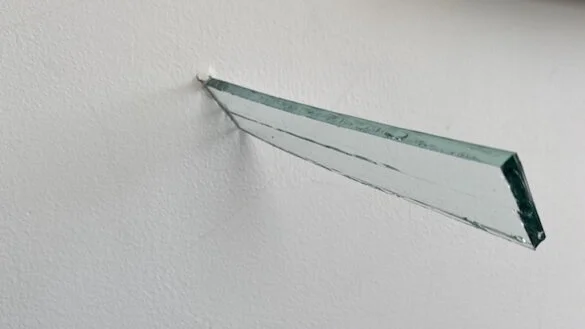Beirut explosion devastates city's arts scene
Citizens of the Lebanese capital and beyond have been rallying to remedy the damage caused by the huge explosion that ripped through Beirut. But while walls and windows can be rebuilt, the explosion has torn the heart out of the city's cultural quarter, damaging or even destroying several of the city's finest art galleries and museums.
Beirut is similar to many sea-facing cities across the world, in that the areas near the port have experienced their ups and downs over the course of history. Once-beautiful gateways to the nation have often suffered from economic deprivation, but frequently the availability of large buildings at relatively low prices attracts an arty young clientele which gradually regenerates the area into a thriving cultural hotspot.
Such was the case with the vibrant Mar Mikhael district, adjacent to the explosion site. Historically a district popular with Armenian immigrants, Mar Mikhael had recently established itself as a bustling nightlife hotspot and home to several galleries.
As recently as Monday night, Galerie Tanit – a contemporary art gallery self-described as the "little sister" of the Tanit in Munich – had hosted a preview of the Lebanese artist Abed Al Kadiri's solo exhibition Remains of the Last Red Rose. Standing on Armenia Street, a few hundred meters from the blast site, 24 hours later it had been "completely destroyed," according to The Art Newspaper.
Also torn asunder was Marfa', named for the Arabic for port: a non-profit contemporary gallery, founded in 2015 to help Lebanese artists build international connections. Again within half a kilometer of the explosion, and closer than the raised Charles Helou expressway that encircles the worst of the devastation, Marfa' felt the force of the blast.
The explosion tore the metal grate off the gallery frontage, exposing the artworks and collapsing the interior into wreckage. "Our gallery has incurred massive damage," explained an Instagram post, but "Marfa' continues despite all."
The Marfa' gallery incurred 'massive damage.' /marfaprojects/Instagram
Beirut's cultural touchstone
Not much farther from the blast site is one of Beirut's most beautiful cultural jewels. Housed in an ornate wedding cake of a mansion dating to 1912 and bequeathed to the nation by art-loving aristocrat Nicolas Ibrahim Sursock, the museum which bears his name has been a cultural center since its 1961 opening.
"This museum has a very long history, which looks like the history of Lebanon," its director Zeina Arida told CGTN Europe – with strong justification. It launched in 1961 with an open-call exhibition for contemporary artists; repeating this idea every year allowed it to collect the country's artistic legacy and kickstart a cultural boom.
"All those who we today consider the historically important modern artists were the contemporary artists participating," explains Arida, "and the museum collected its permanent collection this way. They would bring in external juries, select the best sculpture, the best painting, give awards and acquire the awarded works."
As with much of Lebanon, the Sursock was ravaged by the civil war which raged between 1975 and 1990 and the economic hardships that followed. It finally reopened in 2015 after a $12 million seven-year renovation, allowing residents to once more glory in art and indeed architecture, including much-admired stained-glass windows.
“All the heritage of Lebanon through Sursock is destroyed. It’s really, really terrible”
"It was a beautiful museum where many people used to meet," says Laure d'Hauteville, the director of the Beirut Art Fair who divides her time between the Lebanese and French capitals. "The children used to enjoy the fantastic gardens while the parents were visiting the exhibitions."
Unusually for Lebanon, the private non-profit Sursock received state aid. "It is one of the only institutions with some public subsidy," says Arida, "and this is how this museum was able to serve as a public space dedicated to the arts for the past six years. The museum is free of entrance, it's part of its mission: it caters to the widest audience possible."
Tuesday 4 August 2020 was a typically popular day. Thankfully, staff had evacuated the building of guests in light of the developing dockside fire; 15 minutes later, the explosion blew in the windows, ripping drawings and paintings from the walls as it flung shards of glass and twisted metal around the century-old building.
The Sursock's beloved stained glass was blown out. /Sursock Museum
"Now it's a real mess inside. All the heritage of Lebanon through Sursock is destroyed," says d'Hauteville. "It's really, really terrible. You will need a long time to restore all the paintings – many are destroyed."
Precisely how many, even Arida can't yet say ("I don't have exact figures yet"), but she does describe "an important number of important damages… 20, perhaps 25 paintings. We will start evaluating the damage," not least to the Sursock itself – "a classified building that was renovated recently."
The cost is as yet incalculable, although Arida knows it won't be small. "I'm talking about millions of dollars. Of course, this is nothing in relation to the human loss, to the wounded people, but it is part of our history, of our heritage.
"There are so many old mansions such as this one that were very damaged. Sursock museum might be able to secure support, but individuals also need support because this is our heritage and it's important to preserve the little that remains."
This shard of glass embedded itself into the wall of the Sfeir-Semler Gallery. /Sfeir-Semler Gallery
Widespread damage
In a culturally-minded city, art is not just corralled into one or two showpiece buildings. "The art scene in Beirut is incredible – art is everywhere," enthuses d'Hauteville. "Every day you have a gallery opening, every day you have concerts in the street or in theater or outside. Every day you have a lecture, a new movie with a discussion after. Every day you have conferences everywhere.
"I travel a lot and I visit many countries for Beirut Art Fair, and I've never seen a small country like Lebanon have so much exhibition and so much art. You don't have enough time during the day to visit all the exhibitions everywhere."
That makes for a vibrant city, but it also means more art is at the mercy of such a hugely damaging explosion, especially when much of the artistic quarter is so close to the blast site. Furthermore, galleries in the northern hemisphere tend to prefer north-facing windows, for less intrusive natural lighting; the port is on Beirut's northern shore, with the galleries directly south of it. The immense power of the explosion's shock wave ripped through glazing, shredding it to lethal shards.
"The big damage is the windows, the glass," says d'Hauteville. "Because the explosion was so big, it destroyed all the windows. I saw a photo of Sfeir-Semler gallery and you have a big block of glass inside the wall, like an installation."
The Sfeir-Semler, in the Karantina district to the east of the port, has been a staple in Beirut's arts scene since it was established in 2005, a sister to the gallery in Hamburg, Germany. Mixing conceptual art with political statement, it has become a focus for the Arab artistic world, showcasing globally renowned Lebanese artists like Walid Raad, Etel Adnan, Yto Barrada and Akram Zaatari.
The blast ripped off wall panels, shattered windows and – as d'Hauteville notes – embedded a giant glass shard in the wall. Given the damage, it's miraculous that no lives were lost.
"Our hearts are full of sorrow and we mourn for Beirut," said a gallery statement. "Thanks to all who thought of us, sent a message, a note or a sign. We only have material damage to report, and our team is safe and sound."
Others weren't so fortunate. Gaia Foudolian, the director of Letitia Gallery in the Hamra district, died in the explosion, as did architect Jean-Marc Bonfils, a professor at the Académie Libanaise des Beaux-Arts who designed the building housing the Galerie Tanit. Meanwhile, Saleh Barakat, who owns the eponymous gallery three kilometers west of the blast site, reported that "One of my employees is in intensive care and the gallery has been damaged."
Other stricken galleries face a bleak future. In some cases, the destruction is such that they may be forced to close, especially with Lebanon already racked by economic strife. A spokesperson for Artlab, directly south of the port near the Sursock, said "The gallery has been gravely damaged and I doubt that it is worth reopening given the current conditions."
For d'Hauteville, the destruction drills right down to domestic dwellings. "All the people who exhibit paintings, cultural installations in their home – it's all destroyed."
Rebuilding Beirut... again
Beirut has been here before: it is no stranger to widespread destruction, and has responded artistically. After the civil war ended, "we were facing our past with no explanation," says Arida. "Our elder generation didn't want to hear any more about the war.
"We – the civil society, those who worked in the arts and cultural scene – we are the ones who, with artistic production, tackled this contemporary and recent history. And this is why you see that for so long and until today, the Lebanese war was so much in the middle of the work of the artist, of the writer."
“In Lebanon, art is everywhere. It’s amazing. It’s a country so rich in culture, so rich in creation”
The same creative impetus will arise again, insists d'Hauteville. "An artist never stops creating. I'm sure they will continue – I'm sure now, as we are talking together, some artists are creating. It's the power of life, creating, for an artist."
Although d'Hauteville had already canceled the 2020 Beirut Art Fair due to the pandemic and Lebanon's political upheaval, and now doubts the 2021 fair will go ahead ("Can you imagine one tourist who'll say, 'OK, great, I'll come to Beirut to spend some holiday?"), she has another way to spread the word – and aid the local artistic community.
"My goal now is to organize some events in Europe, in many different countries, about Lebanese art – to highlight and help the arts scene in Lebanon," she says. And she is in no doubt that creativity will continue, believing that art is intrinsic to the Lebanese mindset.
"It's in the idea of the Lebanese. Art is everywhere. In every house you have an artist, a musician, a designer, a painter, a fashion designer, a writer, a singer. It's amazing. It's a country so rich in culture, so rich in creation."
Such is the natural tendency to create, that Arida even hopes to harness the destruction into art. The blast irrevocably destroyed a ceramic by contemporary artist Simone Fattal, but "we kept all the pieces, 15,000 pieces." Arida will send them to Fattal: "I hope maybe she would like to do something with it."
Collaboration will be important, too. Already, citizens are working together to rebuild their homes: they must also do the same with their damaged cultural heritage.
The historical Arab Image Foundation, which suffered significant damage, has already relocated its servers to safe storage at the Sursock Museum, by Arida's invitation. More are welcome as gallery owners pick through the devastation and assess their options.
"Our storage rooms are still sound and they are open to any organization that needs to store its collection," offered Arida.
But it is in the creation of new work that Beirut's artistic community may find new expression. As d'Hauteville puts it, "Art is independence: something very important for people. Art never gives up. Art is always here and art is important for the spirit of the people."
Originally published by CGTN Europe, 9 Aug 2020. Interviews by Katherine Berjikian







